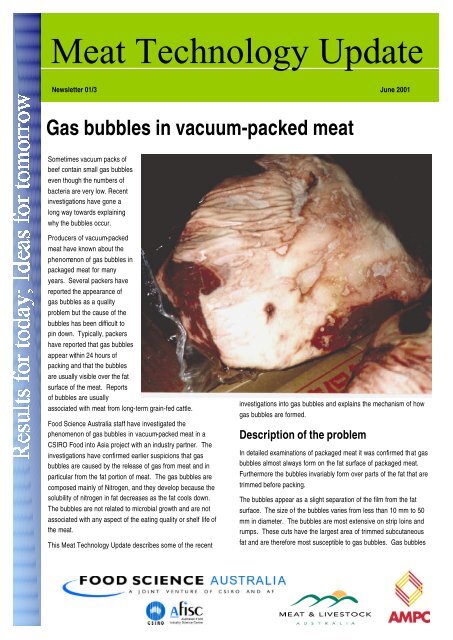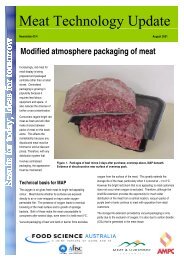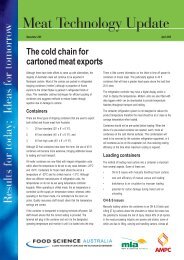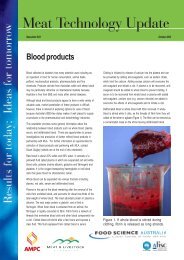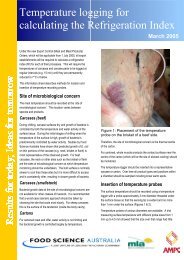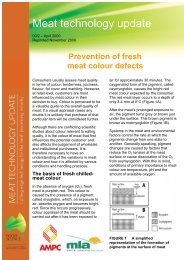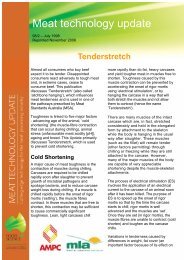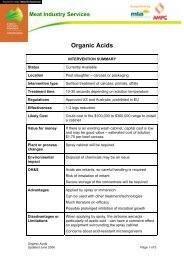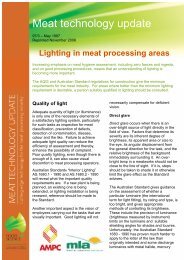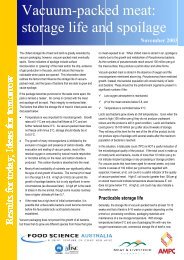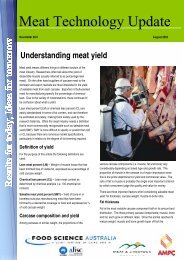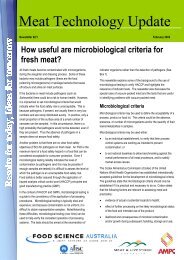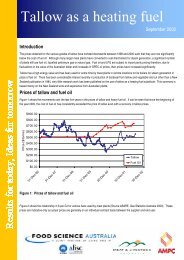Gas bubbles in vacuum-packed meat - Meat Industry Services
Gas bubbles in vacuum-packed meat - Meat Industry Services
Gas bubbles in vacuum-packed meat - Meat Industry Services
You also want an ePaper? Increase the reach of your titles
YUMPU automatically turns print PDFs into web optimized ePapers that Google loves.
<strong>Meat</strong> Technology Update<br />
Newsletter 01/3 June 2001<br />
<strong>Gas</strong> <strong>bubbles</strong> <strong>in</strong> <strong>vacuum</strong>-<strong>packed</strong> <strong>meat</strong><br />
Sometimes <strong>vacuum</strong> packs of<br />
beef conta<strong>in</strong> small gas <strong>bubbles</strong><br />
even though the numbers of<br />
bacteria are very low. Recent<br />
<strong>in</strong>vestigations have gone a<br />
long way towards expla<strong>in</strong><strong>in</strong>g<br />
why the <strong>bubbles</strong> occur.<br />
Producers of <strong>vacuum</strong>-<strong>packed</strong><br />
<strong>meat</strong> have known about the<br />
phenomenon of gas <strong>bubbles</strong> <strong>in</strong><br />
packaged <strong>meat</strong> for many<br />
years. Several packers have<br />
reported the appearance of<br />
gas <strong>bubbles</strong> as a quality<br />
problem but the cause of the<br />
<strong>bubbles</strong> has been difficult to<br />
p<strong>in</strong> down. Typically, packers<br />
have reported that gas <strong>bubbles</strong><br />
appear with<strong>in</strong> 24 hours of<br />
pack<strong>in</strong>g and that the <strong>bubbles</strong><br />
are usually visible over the fat<br />
surface of the <strong>meat</strong>. Reports<br />
of <strong>bubbles</strong> are usually<br />
associated with <strong>meat</strong> from long-term gra<strong>in</strong>-fed cattle.<br />
Food Science Australia staff have <strong>in</strong>vestigated the<br />
phenomenon of gas <strong>bubbles</strong> <strong>in</strong> <strong>vacuum</strong>-<strong>packed</strong> <strong>meat</strong> <strong>in</strong> a<br />
CSIRO Food <strong>in</strong>to Asia project with an <strong>in</strong>dustry partner. The<br />
<strong>in</strong>vestigations have confirmed earlier suspicions that gas<br />
<strong>bubbles</strong> are caused by the release of gas from <strong>meat</strong> and <strong>in</strong><br />
particular from the fat portion of <strong>meat</strong>. The gas <strong>bubbles</strong> are<br />
composed ma<strong>in</strong>ly of Nitrogen, and they develop because the<br />
solubility of nitrogen <strong>in</strong> fat decreases as the fat cools down.<br />
The <strong>bubbles</strong> are not related to microbial growth and are not<br />
associated with any aspect of the eat<strong>in</strong>g quality or shelf life of<br />
the <strong>meat</strong>.<br />
This <strong>Meat</strong> Technology Update describes some of the recent<br />
<strong>in</strong>vestigations <strong>in</strong>to gas <strong>bubbles</strong> and expla<strong>in</strong>s the mechanism of how<br />
gas <strong>bubbles</strong> are formed.<br />
Description of the problem<br />
In detailed exam<strong>in</strong>ations of packaged <strong>meat</strong> it was confirmed that gas<br />
<strong>bubbles</strong> almost always form on the fat surface of packaged <strong>meat</strong>.<br />
Furthermore the <strong>bubbles</strong> <strong>in</strong>variably form over parts of the fat that are<br />
trimmed before pack<strong>in</strong>g.<br />
The <strong>bubbles</strong> appear as a slight separation of the film from the fat<br />
surface. The size of the <strong>bubbles</strong> varies from less than 10 mm to 50<br />
mm <strong>in</strong> diameter. The <strong>bubbles</strong> are most extensive on strip lo<strong>in</strong>s and<br />
rumps. These cuts have the largest area of trimmed subcutaneous<br />
fat and are therefore most susceptible to gas <strong>bubbles</strong>. <strong>Gas</strong> <strong>bubbles</strong>
also affect other cuts such as thick flank, topside, outside and clod.<br />
In these cuts only limited areas of the subcutaneous fat are<br />
trimmed before pack<strong>in</strong>g and these are the areas that are affected<br />
by <strong>bubbles</strong>. <strong>Gas</strong> <strong>bubbles</strong> do not affect cuts 2 that have no<br />
subcutaneous fat such as cube roll and tenderlo<strong>in</strong>. Cuts with large<br />
amounts of <strong>in</strong>ternal fat such as chuck roll may develop small gas<br />
<strong>bubbles</strong> <strong>in</strong> the weep <strong>in</strong>side packs.<br />
Bubbles are visible the day after pack<strong>in</strong>g and grow larger dur<strong>in</strong>g<br />
storage; however, the rate of growth of <strong>bubbles</strong> is slow. The<br />
volume of gas <strong>bubbles</strong> after six weeks storage is usually only four<br />
to five times the volume at 24 hours after pack<strong>in</strong>g. In badly<br />
affected cuts, the amount of gas <strong>in</strong> the packs 24 hours after<br />
pack<strong>in</strong>g is probably less than 1 mL and this may develop to about 5<br />
mL dur<strong>in</strong>g prolonged storage. Initially there may be many small<br />
<strong>bubbles</strong> <strong>in</strong> a pack. The small <strong>bubbles</strong> may grow and coalesce <strong>in</strong>to<br />
a fewer number of large <strong>bubbles</strong>.<br />
Composition of the gas<br />
Although gas <strong>bubbles</strong> are clearly visible <strong>in</strong> <strong>vacuum</strong> packs the day<br />
after pack<strong>in</strong>g, there is not enough gas <strong>in</strong> the packs to collect a<br />
sample for analysis. It takes about six weeks for the gas volume to<br />
<strong>in</strong>crease to a size that can be sampled. The average composition<br />
of gas <strong>in</strong> packs of strip lo<strong>in</strong>s, rumps and outsides sampled from six<br />
to ten weeks after pack<strong>in</strong>g is about 72% nitrogen and 25% carbon<br />
dioxide.<br />
To f<strong>in</strong>d out which gases are generated <strong>in</strong> the first few days after<br />
pack<strong>in</strong>g, some <strong>vacuum</strong> packs of strip lo<strong>in</strong> were prepared with a<br />
small headspace of helium. The headspace was sampled from<br />
three hours to seven days after pack<strong>in</strong>g. The composition of the<br />
headspace changed with<strong>in</strong> three hours of pack<strong>in</strong>g with<br />
concentrations of both nitrogen and carbon dioxide <strong>in</strong>creas<strong>in</strong>g. At<br />
24 hours the headspace conta<strong>in</strong>ed about 20% nitrogen and 5%<br />
carbon dioxide and this <strong>in</strong>creased to 75% nitrogen and 10% carbon<br />
dioxide seven days after pack<strong>in</strong>g.<br />
These experiments confirmed that the small gas <strong>bubbles</strong> that<br />
appear soon after pack<strong>in</strong>g are likely to be composed mostly of<br />
nitrogen with a smaller amount of carbon dioxide.<br />
Where does the gas come from?<br />
It was confirmed that fat is the source of gas <strong>bubbles</strong> by pack<strong>in</strong>g fat<br />
and lean separately. Pieces of subcutaneous fat sliced off rumps<br />
and strip lo<strong>in</strong>s produced gas <strong>bubbles</strong> <strong>in</strong> <strong>vacuum</strong> packs but the<br />
denuded cuts did not. In addition, experiments were conducted <strong>in</strong><br />
which subcutaneous fat was rendered and the result<strong>in</strong>g tallow<br />
<strong>vacuum</strong> <strong>packed</strong>. Even <strong>vacuum</strong>-<strong>packed</strong> tallow can produce<br />
nitrogen gas <strong>bubbles</strong> a few hours after pack<strong>in</strong>g.<br />
One clue to why nitrogen should be released from fat <strong>in</strong> <strong>vacuum</strong><br />
packs came from reports about how mar<strong>in</strong>e mammals may avoid<br />
the bends. One theory is that because nitrogen is five times more<br />
soluble <strong>in</strong> blubber than other tissues, blubber could act as a<br />
reservoir for nitrogen when div<strong>in</strong>g mammals ascend from depth.<br />
Another clue is from studies of the solubility of carbon dioxide <strong>in</strong> fat.<br />
In the case of beef fat, there is a small <strong>in</strong>crease <strong>in</strong> the solubility of<br />
carbon dioxide as the temperature <strong>in</strong>creases from –1 to 10 o C. The<br />
solubility <strong>in</strong>creases more rapidly above 10 o C and reaches a<br />
maximum value at about 22 o C.<br />
The change <strong>in</strong> solubility of gas <strong>in</strong> fat appears to be related to the<br />
complex phase changes <strong>in</strong> the different triglyceride mixtures <strong>in</strong> the<br />
fat. When the fat cools from body temperature the solubility of gases<br />
should <strong>in</strong>crease <strong>in</strong> the liquid portion of the fat but as the different<br />
triglycerides crystallise the solubility of gases decreases. Fat<br />
progressively crystallises as it cools from body temperature and the<br />
solubility of gases <strong>in</strong> subcutaneous fat is low at 0 o C when most of<br />
the fat is solid.<br />
Fat <strong>in</strong> a live animal could be close to be<strong>in</strong>g saturated with nitrogen at<br />
body temperature. After slaughter, as the fat cools, the solubility of<br />
nitrogen <strong>in</strong> the fat decreases. As the various components of the fat<br />
crystallise, nitrogen will be forced out of solution <strong>in</strong> the fat. Nitrogen<br />
that comes out of solution near the surface of the fat can escape<br />
from the surface tissue. Nitrogen that comes out of solution <strong>in</strong> the<br />
deeper layers of subcutaneous fat may be trapped <strong>in</strong> lace by the<br />
crystall<strong>in</strong>e structure of the fat <strong>in</strong> the same way that air <strong>bubbles</strong> are<br />
trapped <strong>in</strong> ice cubes when water is frozen. When the fat is<br />
subsequently trimmed, layers of fat that conta<strong>in</strong> undissolved nitrogen<br />
are exposed and nitrogen is released from the freshly exposed<br />
surface. If the exposed tissue is enclosed <strong>in</strong> a <strong>vacuum</strong> pack, a gas<br />
bubble will appear.<br />
The carbon dioxide component<br />
About a quarter of the volume of gas <strong>bubbles</strong> <strong>in</strong> <strong>vacuum</strong>-<strong>packed</strong><br />
<strong>meat</strong> is carbon dioxide. While the release of nitrogen from fat, as<br />
described above has not been reported previously, there are several<br />
reports about the release of carbon dioxide from <strong>meat</strong>. Some reports<br />
<strong>in</strong>dicate that <strong>meat</strong> produces as much as 0.2 g (i.e. around 100 mL) of<br />
carbon dioxide per kg of <strong>meat</strong> over a five-day period.<br />
It could be expected that gas <strong>bubbles</strong> <strong>in</strong> <strong>vacuum</strong>-<strong>packed</strong> <strong>meat</strong> would<br />
be formed by carbon dioxide. However the solubility of carbon<br />
dioxide <strong>in</strong> <strong>meat</strong> is such that if this gas is produced by <strong>meat</strong> <strong>in</strong> a tight<br />
pack, it will rema<strong>in</strong> dissolved <strong>in</strong> the <strong>meat</strong>. If 1 kg of lean <strong>meat</strong> is<br />
sealed <strong>in</strong> a pack with 960 mL of carbon dioxide, all the gas could be<br />
absorbed caus<strong>in</strong>g the package to collapse around the <strong>meat</strong> leav<strong>in</strong>g<br />
no rema<strong>in</strong><strong>in</strong>g pockets of gas. By contrast, nitrogen is spar<strong>in</strong>gly<br />
soluble <strong>in</strong> water and nitrogen com<strong>in</strong>g out of solution <strong>in</strong> fat is not likely<br />
to re-dissolve <strong>in</strong> lean <strong>meat</strong>.<br />
Studies on the release of carbon dioxide from <strong>meat</strong> have been<br />
conducted on pieces of <strong>meat</strong> sealed <strong>in</strong> atmospheres of <strong>in</strong>ert gas<br />
such as nitrogen. In this case, some of the carbon dioxide produced<br />
by the <strong>meat</strong> will be dissolved <strong>in</strong> the <strong>meat</strong> but an equilibrium will arise<br />
between the carbon dioxide dissolved <strong>in</strong> <strong>meat</strong> tissues and carbon<br />
dioxide <strong>in</strong> the surround<strong>in</strong>g headspace.<br />
This is the situation with gas <strong>bubbles</strong> <strong>in</strong> <strong>vacuum</strong>-<strong>packed</strong> <strong>meat</strong>. If<br />
there is no headspace <strong>in</strong> the <strong>vacuum</strong> pack, carbon dioxide will<br />
rema<strong>in</strong> dissolved <strong>in</strong> the <strong>meat</strong>. If a headspace is created by release
Table 1: Summary of the different characteristics of gas <strong>bubbles</strong> and blown packs<br />
Characteristics of gas <strong>bubbles</strong><br />
Characteristics of gas production by microbes <strong>in</strong> blow packs<br />
<strong>Gas</strong> <strong>bubbles</strong> are visible between the fat surface and film with<strong>in</strong> 20 No sign of gas until at least 7 days after pack<strong>in</strong>g even when conditions<br />
hours<br />
to of <strong>in</strong>duce gas production are used.<br />
pack<strong>in</strong>g.<br />
<strong>Gas</strong> is predom<strong>in</strong>antly nitrogen with about 25% carbon dioxide. <strong>Gas</strong> is predom<strong>in</strong>antly carbon dioxide and also conta<strong>in</strong>s about 30%<br />
hydrogen.<br />
<strong>Gas</strong> <strong>bubbles</strong> are not associated with off-odours or other spoilage. <strong>Gas</strong> <strong>in</strong>cludes odours compounds such as hydrogen sulphide, short<br />
cha<strong>in</strong> fatty acids and am<strong>in</strong>es. <strong>Meat</strong> is obviously spoiled.<br />
<strong>Gas</strong> <strong>bubbles</strong> <strong>in</strong>crease <strong>in</strong> volume slowly over the storage life of the The gas volume <strong>in</strong>creases rapidly after the first production of gas is<br />
product.<br />
noticed.<br />
<strong>Gas</strong> <strong>bubbles</strong> can occur on <strong>meat</strong> with total counts of less than one <strong>Gas</strong> production is associated with counts of ten million per cm 2 and<br />
thousand per cm 2 .<br />
higher.<br />
<strong>Gas</strong> <strong>bubbles</strong> are usually visible between the fat surface and packag<strong>in</strong>g <strong>Gas</strong> is visible <strong>in</strong> the weep and around the <strong>meat</strong>.<br />
film.<br />
of three undissolved nitrogen from the fat tissue, carbon dioxide<br />
dissolved <strong>in</strong> the lean <strong>meat</strong> tissue will occupy some of the<br />
headspace.<br />
<strong>Gas</strong> and microbial activity<br />
One of the concerns about gas <strong>bubbles</strong> <strong>in</strong> <strong>vacuum</strong> packs is that the<br />
gas could be an <strong>in</strong>dicator of microbial activity. While gas can be<br />
produced <strong>in</strong> <strong>vacuum</strong> packs by microbial activity, it is clear that the<br />
formation of gas <strong>bubbles</strong> on the fat surface of <strong>vacuum</strong>-<strong>packed</strong> <strong>meat</strong><br />
is not associated with microbial activity. Table 1 summarises the<br />
difference between gas <strong>bubbles</strong> and production of gas by microbes<br />
<strong>in</strong> blown packs.<br />
Avoid<strong>in</strong>g gas <strong>bubbles</strong><br />
When pieces of freshly cut subcutaneous fat are <strong>vacuum</strong> <strong>packed</strong>,<br />
gas <strong>bubbles</strong> appear <strong>in</strong> the packs. If pieces of fat are left exposed<br />
to air before they are <strong>vacuum</strong> <strong>packed</strong>, the number and size of gas<br />
<strong>bubbles</strong> <strong>in</strong> the packs can be reduced.<br />
If pieces of fat are held chilled for 8 hours before pack<strong>in</strong>g there is a<br />
considerable reduction <strong>in</strong> gas <strong>bubbles</strong> and the <strong>bubbles</strong> would not<br />
be noticed <strong>in</strong> a commercial situation. If the fat is held for 20 hours<br />
before it is <strong>packed</strong>, gas <strong>bubbles</strong> can be totally elim<strong>in</strong>ated.<br />
Therefore one solution to the gas-bubble problem appears to be to<br />
allow the trimmed surface of fat to de-gas before it is <strong>packed</strong>.<br />
Under normal circumstances, a period of at least 8 hours is<br />
necessary to de-gas chilled fat. Dur<strong>in</strong>g de-gass<strong>in</strong>g it seems that<br />
nitrogen that has come out of solution <strong>in</strong> the fat as it cools, escapes<br />
from the exposed surface.<br />
Possible solutions<br />
The cause of gas <strong>bubbles</strong> <strong>in</strong> <strong>vacuum</strong> packs is known but it is not<br />
easy to suggest commercially practical ways to prevent them.<br />
The key to prevent<strong>in</strong>g gas <strong>bubbles</strong> is to stop the release of nitrogen<br />
from the fat surface <strong>in</strong>side <strong>vacuum</strong> packs. This can be done by<br />
allow<strong>in</strong>g trimmed fat surfaces to de-gas before pack<strong>in</strong>g.<br />
Some experiments were conducted on <strong>meat</strong> that was allowed to degas<br />
for 24 hours before it was sealed <strong>in</strong> <strong>vacuum</strong> packs. Rumps and<br />
strip lo<strong>in</strong>s were boned and sliced as usual and were placed <strong>in</strong><br />
<strong>vacuum</strong> bags but were not sealed <strong>in</strong> the bags. The open bags were<br />
placed <strong>in</strong> cartons and put <strong>in</strong> a cartoned <strong>meat</strong> chiller. They were<br />
recovered the next day and the packs were evacuated and sealed.<br />
<strong>Gas</strong> <strong>bubbles</strong> were virtually elim<strong>in</strong>ated from the packs that were<br />
sealed 24 hours after bon<strong>in</strong>g and slic<strong>in</strong>g. <strong>Meat</strong> from the same<br />
production that had been handled conventionally had the usual<br />
<strong>in</strong>cidence of obvious gas <strong>bubbles</strong>.<br />
In most bon<strong>in</strong>g rooms it is not practical to hold naked <strong>meat</strong> or<br />
unsealed packs for 24 hours before the <strong>meat</strong> is sealed <strong>in</strong> <strong>vacuum</strong><br />
packs. Such a process could have some disadvantages and<br />
requires further <strong>in</strong>vestigation. When <strong>meat</strong> was chilled for 24 hours<br />
between bon<strong>in</strong>g and seal<strong>in</strong>g the <strong>meat</strong> <strong>in</strong> packs, there was a tendency<br />
to produce excessive weep <strong>in</strong> the packs. It is not clear why some of<br />
these packs had excessive weep but the quantity of weep would<br />
overshadow the improvement <strong>in</strong> appearance due to the elim<strong>in</strong>ation of<br />
gas <strong>bubbles</strong>.<br />
In addition, if cuts are held <strong>in</strong> unsealed bags <strong>in</strong> a chiller before they<br />
are sealed <strong>in</strong> the packs, there could be some evaporative weight loss<br />
from the <strong>meat</strong>. In one set of experiments the average weight loss<br />
from rumps held for 24 hours before they were sealed <strong>in</strong> packs was<br />
0.5%.<br />
Microbial counts on some of the <strong>meat</strong> that was sealed <strong>in</strong> packs 24<br />
hours after bon<strong>in</strong>g were higher than on <strong>meat</strong> that was <strong>packed</strong> without<br />
delay. However there was no difference <strong>in</strong> the overall keep<strong>in</strong>g<br />
quality of the <strong>meat</strong> from the two treatments over a ten-week storage<br />
period. While it is not expected that a delay between bon<strong>in</strong>g and<br />
pack<strong>in</strong>g will affect the shelf life of the product, this issue needs<br />
further <strong>in</strong>vestigation.<br />
Trimmed fat surfaces should be exposed for at least eight hours to<br />
make a practical improvement <strong>in</strong> the gas bubble problem but the<br />
exposure time can be greatly reduced if the product is held under<br />
<strong>vacuum</strong>. Hold<strong>in</strong>g <strong>meat</strong> at 3 mbar for 1 m<strong>in</strong>ute has little effect on gas<br />
<strong>bubbles</strong> but hold<strong>in</strong>g <strong>meat</strong> under <strong>vacuum</strong> for 5 m<strong>in</strong>utes virtually<br />
elim<strong>in</strong>ates gas <strong>bubbles</strong> when the <strong>meat</strong> is subsequently <strong>vacuum</strong>
<strong>packed</strong> (3 mbar is the typical pressure <strong>in</strong> an evacuated <strong>vacuum</strong><br />
pack<strong>in</strong>g chamber).<br />
Obviously <strong>meat</strong> cannot be held for 5 m<strong>in</strong>utes under <strong>vacuum</strong> as part<br />
of a normal <strong>vacuum</strong> pack<strong>in</strong>g operation. However it may be<br />
possible to hold product <strong>in</strong> a <strong>vacuum</strong> chamber separate from the<br />
packag<strong>in</strong>g mach<strong>in</strong>e for a few m<strong>in</strong>utes before pack<strong>in</strong>g. Such a<br />
treatment should elim<strong>in</strong>ate gas <strong>bubbles</strong>. This solution to gas<br />
<strong>bubbles</strong> has not been fully <strong>in</strong>vestigated and there could be other<br />
unforeseen effects of hold<strong>in</strong>g <strong>meat</strong> under <strong>vacuum</strong> for an extended<br />
period.<br />
Another method of de-gass<strong>in</strong>g fat surfaces before pack<strong>in</strong>g is to trim<br />
the fat on carcases before bon<strong>in</strong>g rather than after bon<strong>in</strong>g .If the<br />
carcases are trimmed at least eight hours before they are boned,<br />
gas <strong>bubbles</strong> <strong>in</strong> <strong>vacuum</strong> packs are greatly reduced or elim<strong>in</strong>ated.<br />
Other solutions<br />
Dur<strong>in</strong>g the course of the experiments, gas <strong>bubbles</strong> were produced<br />
consistently <strong>in</strong> packs of rumps and strip lo<strong>in</strong>s from gra<strong>in</strong>-fed cattle.<br />
However other reports have <strong>in</strong>dicated that the appearance of gas<br />
<strong>bubbles</strong> is sporadic. There is a suggestion that the extent of<br />
<strong>bubbles</strong> is lower <strong>in</strong> w<strong>in</strong>ter months than <strong>in</strong> summer. It is possible<br />
that the structure or composition of subcutaneous fat may have an<br />
effect on the production of gas <strong>bubbles</strong> <strong>in</strong> <strong>vacuum</strong> packs but such<br />
an effect has not been confirmed.<br />
conta<strong>in</strong>ed between the fat surface and pack<strong>in</strong>g film and gas is not<br />
visible <strong>in</strong> other parts of the pack. There may be cases where<br />
nitrogen is released from <strong>in</strong>termuscular fat and appears as small<br />
<strong>bubbles</strong> <strong>in</strong> the weep but these cases are uncommon. Once a<br />
nitrogen headspace is created, carbon dioxide from the <strong>meat</strong> tissue<br />
will equilibrate <strong>in</strong> the headspace. Vacuum packs of cuts with a large<br />
surface area of trimmed fat such as rumps and strip lo<strong>in</strong>s from gra<strong>in</strong>fed<br />
cattle are most likely to exhibit gas <strong>bubbles</strong>.<br />
<strong>Gas</strong> <strong>bubbles</strong> do not affect the shelf life of <strong>vacuum</strong>-<strong>packed</strong> <strong>meat</strong> or<br />
any other aspect of <strong>meat</strong> quality other than appearance <strong>in</strong> the pack.<br />
This type of gas bubble is not related to microbial activity.<br />
De-gass<strong>in</strong>g the trimmed surface of fat at less than 10 ?C before the<br />
<strong>meat</strong> is <strong>packed</strong> can reduce gas <strong>bubbles</strong>. Possible methods of degass<strong>in</strong>g<br />
are:<br />
• hold<strong>in</strong>g boned and trimmed cuts <strong>in</strong> a chiller for at least eight<br />
hours before <strong>vacuum</strong> pack<strong>in</strong>g;<br />
• trimm<strong>in</strong>g the fat on carcases at least eight hours before<br />
bon<strong>in</strong>g; and<br />
• hold<strong>in</strong>g cuts under <strong>vacuum</strong> for five m<strong>in</strong>utes before seal<strong>in</strong>g <strong>in</strong><br />
<strong>vacuum</strong> packs.<br />
Conclusion<br />
<strong>Gas</strong> <strong>bubbles</strong> <strong>in</strong> <strong>vacuum</strong>-<strong>packed</strong> <strong>meat</strong> are formed by release of<br />
nitrogen from freshly trimmed fat surfaces. The nitrogen is usually<br />
The <strong>in</strong>formation conta<strong>in</strong>ed here<strong>in</strong> is an outl<strong>in</strong>e only and should not be relied on <strong>in</strong> place of professional advice on any specific matter.<br />
For more <strong>in</strong>formation, contact one of the <strong>Meat</strong> <strong>Industry</strong> <strong>Services</strong> staff listed below.<br />
Food Science Australia <strong>Meat</strong> <strong>Industry</strong> <strong>Services</strong> Section<br />
The <strong>Meat</strong> <strong>Industry</strong> <strong>Services</strong> (MIS) Section of Food Science Australia is an <strong>in</strong>itiative supported by <strong>Meat</strong> and Livestock Australia (MLA) and the<br />
Australian <strong>Meat</strong> Processor Corporation (AMPC) to facilitate market access for, and support world-class practices <strong>in</strong>, Australia ’s <strong>meat</strong> <strong>in</strong>dustry.<br />
Need additional <strong>in</strong>formation help, <strong>in</strong>formation or advice?<br />
Contact any of the follow<strong>in</strong>g<br />
Ian Eustace Bill Spooncer Neil McPhail Jocelyn Midgley Chris Sentance<br />
Food Science Australia Food Science Australia Food Science Australia Food Science Australia PO Box 178<br />
PO Box 3312 PO Box 181 PO Box 3312 PO Box 3312 FLAGSTAFF HILL<br />
TINGALPA DC QLD 4173 KURMOND NSW 2757 TINGALPA DC QLD 4173 TINGALPA DC QLD 4173 SA 5159<br />
Telephone 07 3214 2117 Telephone 02 4567 7952 Telephone 07 3214 2119 Telephone 07 3214 2109 Telephone 08 8370 7466<br />
Facsimile 07 3214 2103 Facsimile 02 4567 8952 Facsimile 07 3214 2103 Facsimile 07 3214 2103 Facsimile 08 8370 7566<br />
Mobile 0414 336 724 Mobile 0414 648 387 Mobile 0414 336 907 Mobile 0414 647 231 Mobile 0419 944 022<br />
Past copies of this newsletter can be obta<strong>in</strong>ed from: www.<strong>meat</strong>update.csiro.au


